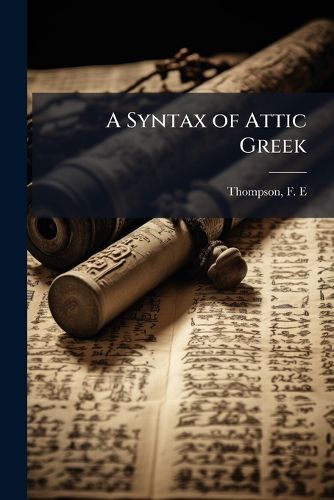Readings Newsletter
Become a Readings Member to make your shopping experience even easier.
Sign in or sign up for free!
You’re not far away from qualifying for FREE standard shipping within Australia
You’ve qualified for FREE standard shipping within Australia
The cart is loading…






"A Syntax of Attic Greek" is a comprehensive guide to the grammatical structure of the Attic dialect of ancient Greek. Written by F.E. Thompson, this meticulously detailed work offers a systematic exploration of syntax, providing students and scholars with invaluable insights into the intricacies of the language used by classical Athenian writers. The book covers a wide array of syntactical phenomena, from the agreement of verbs and nouns to the complex structures of subordinate clauses.
This book remains an essential resource for anyone seeking a deeper understanding of Attic Greek. Its detailed explanations and numerous examples make it indispensable for both classroom use and independent study. "A Syntax of Attic Greek" is a lasting contribution to the field of classical linguistics.
This work has been selected by scholars as being culturally important, and is part of the knowledge base of civilization as we know it. This work was reproduced from the original artifact, and remains as true to the original work as possible. Therefore, you will see the original copyright references, library stamps (as most of these works have been housed in our most important libraries around the world), and other notations in the work.
This work is in the public domain in the United States of America, and possibly other nations. Within the United States, you may freely copy and distribute this work, as no entity (individual or corporate) has a copyright on the body of the work.
As a reproduction of a historical artifact, this work may contain missing or blurred pages, poor pictures, errant marks, etc. Scholars believe, and we concur, that this work is important enough to be preserved, reproduced, and made generally available to the public. We appreciate your support of the preservation process, and thank you for being an important part of keeping this knowledge alive and relevant.
$9.00 standard shipping within Australia
FREE standard shipping within Australia for orders over $100.00
Express & International shipping calculated at checkout
"A Syntax of Attic Greek" is a comprehensive guide to the grammatical structure of the Attic dialect of ancient Greek. Written by F.E. Thompson, this meticulously detailed work offers a systematic exploration of syntax, providing students and scholars with invaluable insights into the intricacies of the language used by classical Athenian writers. The book covers a wide array of syntactical phenomena, from the agreement of verbs and nouns to the complex structures of subordinate clauses.
This book remains an essential resource for anyone seeking a deeper understanding of Attic Greek. Its detailed explanations and numerous examples make it indispensable for both classroom use and independent study. "A Syntax of Attic Greek" is a lasting contribution to the field of classical linguistics.
This work has been selected by scholars as being culturally important, and is part of the knowledge base of civilization as we know it. This work was reproduced from the original artifact, and remains as true to the original work as possible. Therefore, you will see the original copyright references, library stamps (as most of these works have been housed in our most important libraries around the world), and other notations in the work.
This work is in the public domain in the United States of America, and possibly other nations. Within the United States, you may freely copy and distribute this work, as no entity (individual or corporate) has a copyright on the body of the work.
As a reproduction of a historical artifact, this work may contain missing or blurred pages, poor pictures, errant marks, etc. Scholars believe, and we concur, that this work is important enough to be preserved, reproduced, and made generally available to the public. We appreciate your support of the preservation process, and thank you for being an important part of keeping this knowledge alive and relevant.